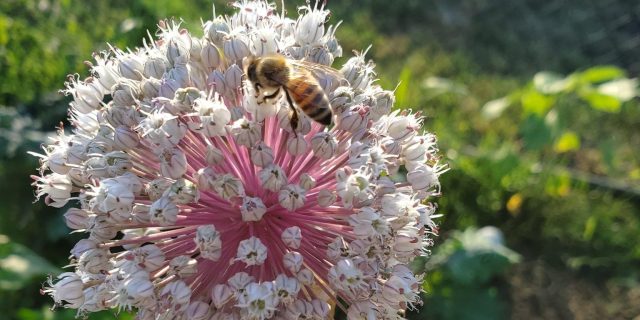11
Aug
Of Multiple Stressors, Pesticides Are the Most Harmful to Bees by Acting Synergistically to Increase Mortality

(Beyond Pesticides, August 11, 2021) Multiple stressors, including pesticides, parasites, and poor nutrition, act synergistically to increase the risk of bee mortality, according to a meta-analysis recently published in the journal Nature. The findings are yet another indictment of the U.S. pesticide regulatory system’s ability to protect pollinators, as the authors note that their results, “…demonstrate that the regulatory process in its current form does not protect bees from the unwanted consequences of complex agrochemical exposure.” As scientific community continues to confirm the dangers of pesticides and other anthropogenic stressors to pollinators, it remains up to advocates and other concerned residents to get regulators and policymakers to listen to and act on these critically important conclusions.
Scientists aimed to evaluate how combinations of multiple pesticides, parasites, and lack of floral resulted in bee death or subchronic effects that impacted overall fitness (reproductive ability, colony health, etc), behavior, parasite load, or immune response. The effects of multiple stressors can be characterized as antagonistic when stressors cancel themselves out, additive when the impacts seen are what would be predicted when summing the individual effects, and synergistic when the effects are multiple times more harmful than what would be predicted additively. To conduct the analysis, researchers began with nearly 15,000 papers on bee health, and narrowed down their review to 90 studies that observed over 350 interactions between multiple stressors.
At the most general level, multiple stressors were synergistic in the context of bee mortality, but additive for effects on overall fitness. Looking further into the data, it was determined that exposure to multiple pesticides had the most robust connection to synergistic impacts. Researchers suspected that studies exposing pollinators above field-realistic doses may have contributed to that result, but a reanalysis that focused solely on pesticide levels pollinators would encounter in the wild found the same results. “Interactions between multiple agrochemicals significantly increase bee mortality,” said lead author Harry Siviter, PhD.
Most other stressors exhibited additive impacts on bee mortality and health. Interactions between nutritional health, parasite load, and pesticide exposure were summed predictably for bee mortality. Differences, however, were seen for the overall combined effects of multiple stressors on parasite load. These effects are characterized as antagonistic. Scientists suspect that the cause is likely because two parasites will attempt to outcompete each other, but note that this could vary by parasite type and may be due to variability in the study dataset.
“Our results show that although many classes of anthropogenic stressors may have additive effects on bee mortality and fitness proxies, exposure to combined agrochemicals can have synergistic effects that are more detrimental than would be predicted by independent risk assessments,” the study reads.
The U.S. Environmental Protection Agency has access to the same studies analyzed as part of this meta-analysis. Yet, the agency continues to register bee-toxic pesticides and permit them to be used in combination with other active and inert pesticide ingredients. Unfortunately, a large part of the problem is that the data EPA relies upon is not the data these scientists are analyzing in the open literature – instead, EPA primarily uses data supplied by the pesticide industry to determine risk. In just one example of EPA’s lack of adequate oversight and transparency, in 2019, the agency reregistered the bee-toxic insecticide sulfoxaflor (a pesticide beekeepers had, just a few years earlier, successfully banned in the courts). As part of its new registration, EPA relied on studies from pesticide manufacturers and decided to waive prior restrictions on ‘tank mixing’ the insecticide with other toxic pesticides. This was done “because data show that there is no additional risk when sulfoxaflor is tank mixed with other compounds,” EPA wrote.
Authors of the current meta-study indicate that their results should not be ignored by regulators. They suggest a range of prescriptions to enhance the ability for regulators to determine risk, such as requiring tests on common pesticide tank mixtures, or conducting post-licensing analysis – monitoring pesticide product applications in the field as a last step in the regulatory review process.
While these changes would improve understanding, there are other forces at play in regards to the pesticide review process. Most notably is the depth of corruption within EPA’s Office of Pesticide Programs. According to recent reporting in the Intercept, rank and file EPA employees have been bullied and brow beat into approving toxic chemicals that they know are unsafe. Many advocates wonder how effective new studies and protocols could be if the agency continues to act as a revolving door between the pesticide and agrichemical industry.
Structural changes are needed to shake up EPA and hold pesticide manufacturers accountable. The Saving America’s Pollinators Act (SAPA), introduced in Congress this year as HR4079, would start that process. The bill that saves the bees would put pollinator experts in charge, not EPA’s pesticide industry flunkies. These experts would be empowered to review all data of concern for pollinators and require EPA to restrict them if the chemicals are found to be an unacceptable hazard to pollinators or the habitat they rely upon. This is a common sense proposal that cannot succeed without strong support from the public. Take action today to urge your member of Congress to cosponsor SAPA, and follow up with a phone call. If your member is already a cosponsor, make sure to send a note thanking them for their support.
All unattributed positions and opinions in this piece are those of Beyond Pesticides.










